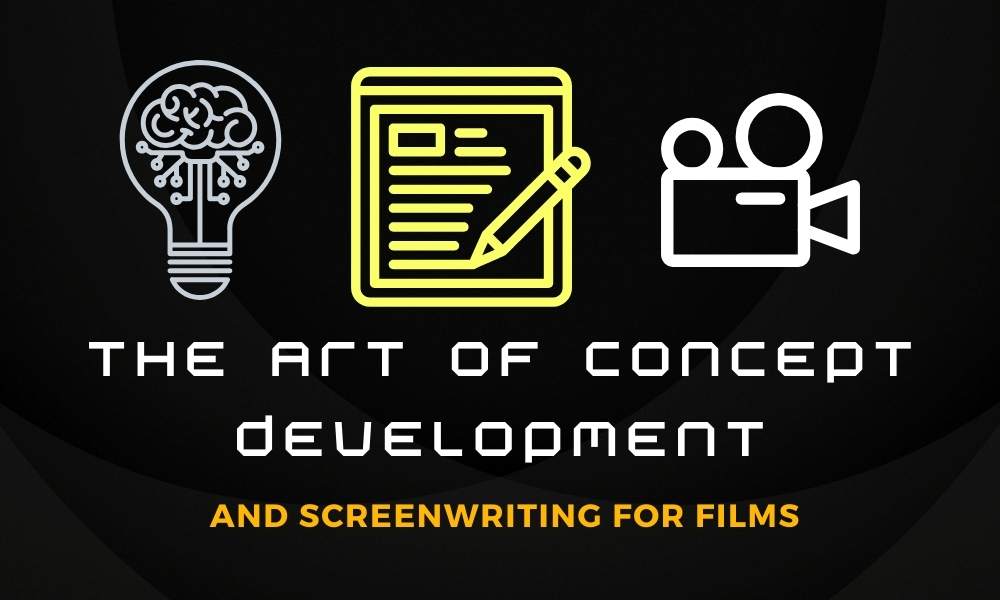Have you ever wondered what it takes to turn a raw idea into a blockbuster film?
It’s all about the art of concept development and screenwriting.
You’ll dive into the intricate process of transforming a simple concept into a compelling film narrative.
You’ll learn how to craft engaging dialogues, create memorable characters, and structure a gripping narrative that keeps audiences on the edge.
It’s not just about writing but about visualizing, experimenting, and refining until you’ve got a script ready to light up the silver screen.
So, get ready to pull back the curtain on the magic of film creation.
Understanding Film Concept Development

In your journey to master film concept development, you’ll first need to grasp its basic principles and importance in filmmaking. Conceptual inspiration, the seed from which all creativity sprouts, is paramount. It’s where you’ll find the raw, unrefined ideas that eventually shape into a compelling narrative.
As you explore genre, you’ll uncover the tropes and conventions that define each film category. You’ll see how these established rules can be bent, twisted, and completely shattered to create something unique. Remember, originality is key in concept development. So, don’t be afraid to experiment, push boundaries, or challenge the status quo.
This is your chance to craft a rich, engaging, and ultimately unforgettable story.
The Essence of Screenwriting
After mastering the nuances of concept development, you’ll find that a significant amount of your filmmaking journey lies in understanding the essence of screenwriting. This craft is about more than just writing dialogue; it’s about constructing a visual narrative.
Screenwriting is composed of two key elements:
- Screenplay formatting: This is the skeleton of your story, dictating its structure. Proper formatting is essential, guiding the reader’s eye and creating a rhythm for the narrative.
- Scene headings, action lines, character names, and dialogue each serve a purpose and need to be presented correctly.
- Storyboarding techniques: These are your tools for visualizing the script. This is where your imagination truly comes to life.
- Sketching scenes, plotting camera angles, and planning transitions – are all integral to breathing life into your narrative.
Screenwriting is the bridge between your concept and the tangible film it becomes.
Creating Memorable Characters
Beyond the structure and visualization of your screenplay, you’ll need to focus on creating memorable characters, as they’re the heart and soul of your narrative. These aren’t mere pawns in your plot but individuals whose personality construction makes them unique and engaging.
Start by defining their motivations. What drives them? What do they fear or desire? This gives them depth, making them relatable and unforgettable.
Next, craft their personality. Are they cheerful or brooding, shy or extroverted? This shapes their dialogue and actions, providing consistency throughout your screenplay.
Crafting Engaging Dialogues
Having established your characters’ motivations and personalities, it’s now your job to let them speak and let their words and conversations draw your audience in, crafting engaging dialogues that feel authentic and compelling. Dialogue realism and emotional conveyance are key elements in achieving this.
Consider the following to enhance dialogue realism:
- Remember your characters’ backgrounds, their ways of thinking, and their speech patterns.
- Ensure the dialogue fits the situation.
To master emotional conveyance:
- Let your characters express their feelings, not just through words but also through actions and reactions.
- Utilize silence and subtext effectively.
Structuring a Gripping Narrative
The first step in creating a gripping narrative is constructing a plot structure that will keep your audience on the edge of their seats.
You’ll need suspense-building, captivating readers with the promise of unseen revelations. Unleash plot twists at just the right moments; this strategy will continuously redefine their understanding of the story.
Picture your plot as a winding highway; the unexpected turns make the journey exhilarating. Weave in elements of surprise, and suddenly, your narrative becomes an addictive page-turner.
Your audience is hooked, eager to unravel your carefully crafted mystery. Complement this with compelling characters and engaging dialogues, and you’re well on your way to crafting a narrative that’s not just gripping but unforgettable.
Conclusion
Mastering the art of film concept development and screenwriting means weaving a tapestry of compelling narratives, unforgettable characters, and riveting dialogue. It’s a dance of imagination, structure, raw creativity, and meticulous planning.
Never forget that every word you pen shapes the heart of your film, and each character you craft breathes life into it. Keep honing your craft; soon enough, your screenplays will captivate the heart, thrill the mind, and stir the soul.
Ready to Get Your Story to the Masses?
Book a free consultation with 4th Street Productions today, and let’s create something extraordinary together!

